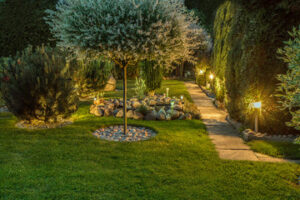Landscaping Fayetteville AR enhances curb appeal, increases property value, and creates beautiful outdoor spaces to relax or entertain. It also improves the quality of life in urban settings with physical and mental health benefits.

Unity is key to a successful landscape design. Repeating similar plant species or using similar building materials in pathways and patios cultivates unity and a sense of harmony.
Designing a landscape involves creating a harmonious and visually appealing arrangement of outdoor elements. This includes selecting and placing plants, assessing the terrain and making adjustments like leveling or grading, and adding structural features such as pathways, patios, and water features. It also includes incorporating environmental considerations like water management and preservation, soil erosion prevention, and wildlife habitats.
Landscaping can be done on a large scale, from public parks to residential gardens. It can also be done with a variety of materials, from natural wood and stone to hardscapes like pavers and concrete. The most important thing is to choose a style that suits the homeowner’s personality and preferences. For example, some people may prefer a more formal garden with neatly trimmed hedges and symmetrical plantings, while others might prefer a more organic, natural look.
The design of a landscape is an art form that can enhance the aesthetics of a property and increase its value. It can also be used to create a functional outdoor space for relaxing, entertaining, or growing food. A well-designed yard can also reduce energy costs, improve air quality, and provide a habitat for wildlife.
When designing a landscape, it’s important to consider the weather and climate of the area. This will influence which plants are best suited to the environment and how they grow, as well as how much maintenance is required. It’s also important to consider how the landscape will look over time, as plants will change in shape and size as they mature.
Another important factor to consider is the use of natural and recycled materials. Choosing sustainable materials like recycled or reclaimed pavers, bricks, and wood can help to reduce the environmental impact of a landscape. Using eco-friendly gardening products, such as non-toxic preservatives, stains, and paints, is another way to be more environmentally responsible when creating a landscape.
It’s important to create a balance between the different elements of a landscape, including plants, rocks, mulch, and other materials. Using a variety of textures and colors can add interest to the space. It’s also a good idea to incorporate water features into the landscape, as this can add visual appeal and create a sense of calm.
Materials
Landscaping materials transform outdoor spaces into functional and aesthetically pleasing areas that can enhance the value of your property. Whether you are a professional landscaper or a homeowner embarking on your first landscaping project, the right materials can make or break your design. It is important to select high-quality materials that will stand the test of time and withstand Wisconsin’s climate conditions.
Natural materials like rocks, wood, and soils are versatile and easy to work with. They are also eco-friendly and add an organic element to your design. These materials also contribute to the health of your plants and promote soil stability and drainage.
The types of materials you choose depend on your landscaping goals and budget. For example, if you are looking for an affordable option, pea gravel is a great choice for creating eye-catching garden beds and pathways. Pea gravel is a finely crushed rock that is ideal for maintaining soil moisture and suppressing weed growth. It is also a cost-effective alternative to mulch or concrete pavers.
Other common landscaping materials include river rock, flagstone, lava rock, and brick. Each of these has its own unique texture and color that can be used to create different effects in your garden or hardscape area. These types of materials are popular for building pathways, patios, and retaining walls in your yard. They are durable and long-lasting, which minimizes the need for frequent repairs or replacements.
For a more rustic look, you can use wooden landscaping materials such as poles or stakes. These materials can also be used to build structures like gazebos or raised garden beds. They can also be used to decorate your yard with rustic-themed elements such as a fireplace and seating area. Wooden materials are also great for edging garden beds and creating unique walkways using herringbone or basketweave patterns.
Other landscaping materials to consider include compost and mulch. Compost and mulch are eco-friendly because they help to keep the soil healthy by reducing the need for fertilizers and pesticides. They also reduce the amount of waste sent to landfills. When choosing mulch or compost, look for options made from recycled products to reduce your environmental impact. It is also a good idea to source these materials locally so they don’t require as much energy to transport.
Installation
Landscaping involves the installation of plants, rocks, mulch, water features, and outdoor structures like fences and decks to create a functional and beautiful outdoor space. The practice is intended to enhance a property’s value and appeal, as well as provide an inviting atmosphere for family and friends to relax and enjoy the outdoors. It is not limited to residential properties, but can also be applied to commercial sites, city parks, and other public spaces.
Landscapers have a unique set of skills that help them bring the vision of a homeowner to life. They use a combination of science, art, and creativity to design and modify the layout of outdoor spaces. They must consider a wide range of factors, including climate, visual appeal, and usability. Landscaping professionals are skilled at creating balanced gardens and outdoor living areas that serve a variety of purposes.
The landscaping process begins with an initial consultation to discuss a homeowner’s goals and needs. A professional can then conduct a thorough site analysis to assess the soil conditions, sun and wind exposure, and drainage issues. This information is used to develop a detailed plan that will address the client’s objectives.
Once the design is finalized, the landscapers can begin to implement their plans. Softscape installations include the planting of trees, flowers, and shrubs, as well as the creation of open lawns and garden beds. The landscapers may also add hardscape elements to the yard, such as walkways and patios. These structures can be constructed from a variety of materials, such as stone, wood, and pavers. They can be arranged in a number of ways, such as a meandering path through a flowerbed or a timber retaining wall that tames a slope.
In addition to installing softscapes and hardscapes, landscaping professionals can also install lighting, irrigation systems, and water features. Water features like ponds and fountains can add a touch of elegance to the backyard, while also serving a practical purpose by increasing water retention. This reduces the risk of drought conditions, and also helps keep weeds and other unwanted vegetation under control.
Maintenance
Landscape maintenance is the ongoing care and upkeep of your property’s plants, trees, grass, flowers, shrubs, and other features. It includes tasks such as watering, fertilizing, mowing, trimming, weeding, and pest control. Proper maintenance keeps your landscape healthy and attractive and can improve the value of your home or business. It also helps protect the environment by reducing pollution, noise, and erosion.
The type of landscaping you choose depends on your preferences and the purpose of the space. For example, you may want a lawn for recreational activities, a garden for growing vegetables, or a set of trimmed hedges for privacy and security. Landscapers can help you select the right plants for your space and create a design that meets your needs.
In addition, you can add hardscape features like paths, patios, and decorative stone elements to your landscape. This adds a sense of structure to your outdoor space and makes it easier to navigate. Landscaping can be very creative and incorporate a variety of styles, from natural looks to more modern layouts.
As with any project, the quality of the finished product is only as good as the work that goes into it. It is important to have a plan and budget in place before beginning your landscaping project. This will ensure that you are happy with the results and can afford any necessary repairs or maintenance.
Your location’s climate will also affect the maintenance needs of your landscaping. For example, certain plants thrive in sunny areas while others need shade. The weather also influences the best time of day to water your landscape to minimize evaporation.
Our comprehensive landscape services include weekly or bi-weekly mowing, pruning, and mulching to promote healthy growth. We also offer bed and garden cleanup, aeration, and lime application to balance soil pH and encourage grass health. Additionally, we can handle snow removal and de-icing services for safe access to parking lots and walkways.


